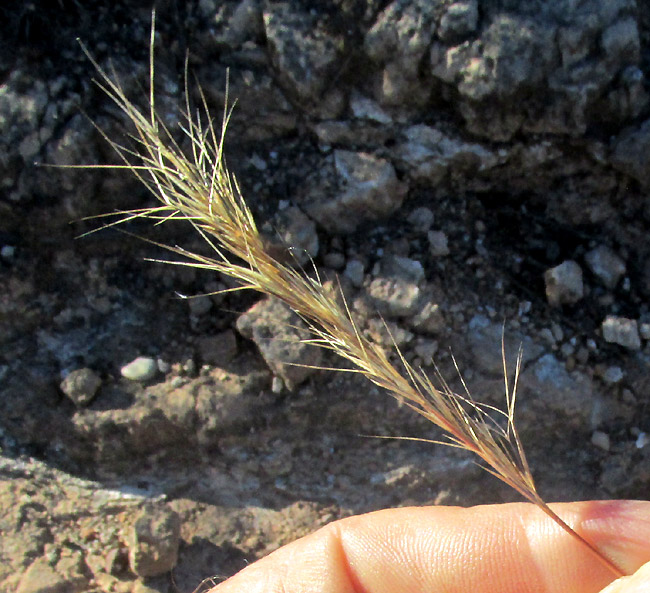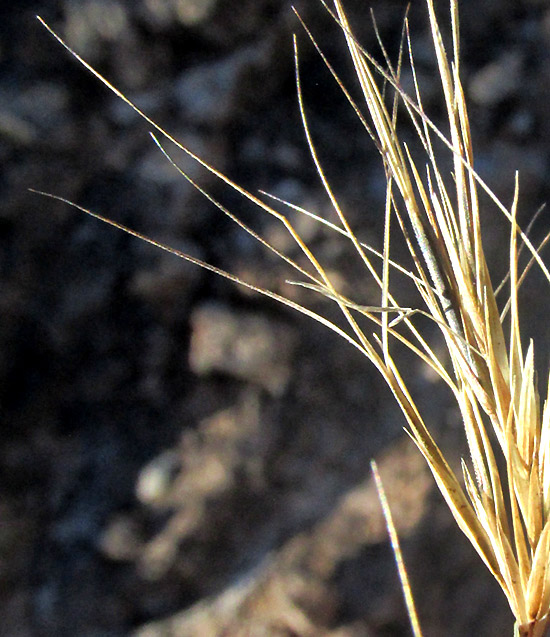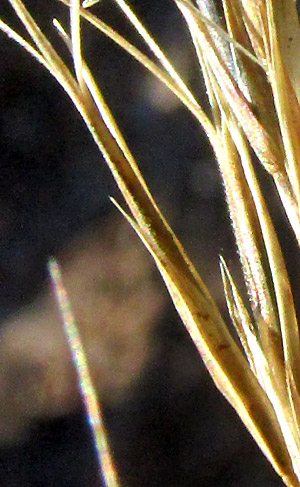Excerpts from Jim Conrad's
Naturalist Newsletter
Entry dated February 5, 2024, issued from near Tequisquiapan; elevation about 1,900m, (6200 ft), ~N20.57°, ~W99.89°; Querétaro state, MÉXICO
SIXWEEKS THREEAWN

The above grass, bristling with one-seeded, caryopsis-type fruits ready for dissemination, rooted in gravelly talus below an old roadcut through a rhyolytic lava flow. It's seen during the normal dry season of a continuing two-year-long period the North American Drought Monitor describes as a D3 Extreme Drought; this grass definitely is adapted for dry very dry conditions.

The panicle-type inflorescence, ignoring its spreading bristles, is slender and compact, its branches held so close to the rachis that they're not apparent.

The above picture shows a single spikelet containing a single, slender floret, the spikelet's base seen in the image's lower, right corner. An important identification feature is that the spikelet's two, scale-like glumes, which subtend the floret, are of very unequal lengths, with one longer than the floret. Atop the floret, the lemma's tip divides into three spreading bristles, or awns, the central one longer than the lateral ones.

The image at the right highlights the glumes' different heights, and the lemma top where the three awns separate.
In the Americas, if you have a grass whose florets bear three conspicuous, needle-like awns arising at the lemma's tip, you have the big genus Aristida, whose approximately 300 worldwide-occurring species often are known as three-awn grasses. The species occupy a variety of niches, but mostly they occur in semiarid grasslands, of which Mexico has plenty. Since livestock tend to avoid feeding on mature plants with bristly spikelets, when three-awn grass species become more common than in the past, it's a sign of overgrazing, and Mexico has plenty of that, too.
In upland central Mexico, if you have an Aristida with such long awns, the inflorescence is compact and slender, and the spiklet's glumes are of strikingly different heights, you have ARISTIDA ADSCENSIONIS.
Aristida adscensionis is native to most of the Earth's warmer, dry environments, except in Australia, and as such is known by many names. In English it's most common names appear to be Sixweeks Threeawn and Common Needlegrass. The species is described as growing on waste ground, along roadsides and on degraded rangelands and dry hillsides, often in sandy soil.
Distributed over such a wide area, it's highly variable in height, panicle size and awn development. Several varieties have been described but, as the Flora of North America says, "None are recognized here because most of the variation appears to be environmentally induced." Kew's Plants of the World Online database currently lists 138 taxon names, all now regarded simply as Aristida adscensionis, a name bestowed by Linnaeus himself in 1753.
Despite livestock usually avoiding bristly mature plants, tender, young Aristida adscensionis grass is eaten and considered nutritious; in some places it's baled for hay. Since the species rapidly colonizes bare ground, waste and disturbed ground, it's regarded as both an aggressive invasive, and as valuable for stabilizing land and retarding erosion. In some countries it controls the advancement sand dunes.
In this particular part of central Mexico's semiarid altiplano, Aristida adscensionis is not particularly noticeable. Grasses such as Bouteloua curtipendula and Melinis repens are much more common.
C.R. Dodge's classic 1897 book Useful Fiber Plants of the World reports that fiber from the roots of Aristida adscensionis, at least in the 1800s, was used to make certain kinds of brushes and "hot-weather screens," while the stems, or culms, were useful for making frames for the production of paper.